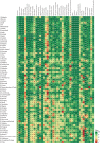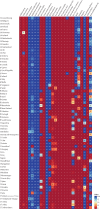Measuring progress from 1990 to 2017 and projecting attainment to 2030 of the health-related Sustainable Development Goals for 195 countries and territories: a systematic analysis for the Global Burden of Disease Study 2017
- PMID: 30496107
- PMCID: PMC6227911
- DOI: 10.1016/S0140-6736(18)32281-5
Measuring progress from 1990 to 2017 and projecting attainment to 2030 of the health-related Sustainable Development Goals for 195 countries and territories: a systematic analysis for the Global Burden of Disease Study 2017
Erratum in
-
Department of Error.Lancet. 2019 Jun 22;393(10190):e44. doi: 10.1016/S0140-6736(19)31048-7. Lancet. 2019. PMID: 31232378 Free PMC article. No abstract available.
Abstract
Background: Efforts to establish the 2015 baseline and monitor early implementation of the UN Sustainable Development Goals (SDGs) highlight both great potential for and threats to improving health by 2030. To fully deliver on the SDG aim of "leaving no one behind", it is increasingly important to examine the health-related SDGs beyond national-level estimates. As part of the Global Burden of Diseases, Injuries, and Risk Factors Study 2017 (GBD 2017), we measured progress on 41 of 52 health-related SDG indicators and estimated the health-related SDG index for 195 countries and territories for the period 1990-2017, projected indicators to 2030, and analysed global attainment.
Methods: We measured progress on 41 health-related SDG indicators from 1990 to 2017, an increase of four indicators since GBD 2016 (new indicators were health worker density, sexual violence by non-intimate partners, population census status, and prevalence of physical and sexual violence [reported separately]). We also improved the measurement of several previously reported indicators. We constructed national-level estimates and, for a subset of health-related SDGs, examined indicator-level differences by sex and Socio-demographic Index (SDI) quintile. We also did subnational assessments of performance for selected countries. To construct the health-related SDG index, we transformed the value for each indicator on a scale of 0-100, with 0 as the 2·5th percentile and 100 as the 97·5th percentile of 1000 draws calculated from 1990 to 2030, and took the geometric mean of the scaled indicators by target. To generate projections through 2030, we used a forecasting framework that drew estimates from the broader GBD study and used weighted averages of indicator-specific and country-specific annualised rates of change from 1990 to 2017 to inform future estimates. We assessed attainment of indicators with defined targets in two ways: first, using mean values projected for 2030, and then using the probability of attainment in 2030 calculated from 1000 draws. We also did a global attainment analysis of the feasibility of attaining SDG targets on the basis of past trends. Using 2015 global averages of indicators with defined SDG targets, we calculated the global annualised rates of change required from 2015 to 2030 to meet these targets, and then identified in what percentiles the required global annualised rates of change fell in the distribution of country-level rates of change from 1990 to 2015. We took the mean of these global percentile values across indicators and applied the past rate of change at this mean global percentile to all health-related SDG indicators, irrespective of target definition, to estimate the equivalent 2030 global average value and percentage change from 2015 to 2030 for each indicator.
Findings: The global median health-related SDG index in 2017 was 59·4 (IQR 35·4-67·3), ranging from a low of 11·6 (95% uncertainty interval 9·6-14·0) to a high of 84·9 (83·1-86·7). SDG index values in countries assessed at the subnational level varied substantially, particularly in China and India, although scores in Japan and the UK were more homogeneous. Indicators also varied by SDI quintile and sex, with males having worse outcomes than females for non-communicable disease (NCD) mortality, alcohol use, and smoking, among others. Most countries were projected to have a higher health-related SDG index in 2030 than in 2017, while country-level probabilities of attainment by 2030 varied widely by indicator. Under-5 mortality, neonatal mortality, maternal mortality ratio, and malaria indicators had the most countries with at least 95% probability of target attainment. Other indicators, including NCD mortality and suicide mortality, had no countries projected to meet corresponding SDG targets on the basis of projected mean values for 2030 but showed some probability of attainment by 2030. For some indicators, including child malnutrition, several infectious diseases, and most violence measures, the annualised rates of change required to meet SDG targets far exceeded the pace of progress achieved by any country in the recent past. We found that applying the mean global annualised rate of change to indicators without defined targets would equate to about 19% and 22% reductions in global smoking and alcohol consumption, respectively; a 47% decline in adolescent birth rates; and a more than 85% increase in health worker density per 1000 population by 2030.
Interpretation: The GBD study offers a unique, robust platform for monitoring the health-related SDGs across demographic and geographic dimensions. Our findings underscore the importance of increased collection and analysis of disaggregated data and highlight where more deliberate design or targeting of interventions could accelerate progress in attaining the SDGs. Current projections show that many health-related SDG indicators, NCDs, NCD-related risks, and violence-related indicators will require a concerted shift away from what might have driven past gains-curative interventions in the case of NCDs-towards multisectoral, prevention-oriented policy action and investments to achieve SDG aims. Notably, several targets, if they are to be met by 2030, demand a pace of progress that no country has achieved in the recent past. The future is fundamentally uncertain, and no model can fully predict what breakthroughs or events might alter the course of the SDGs. What is clear is that our actions-or inaction-today will ultimately dictate how close the world, collectively, can get to leaving no one behind by 2030.
Funding: Bill & Melinda Gates Foundation.
Copyright © 2018 The Author(s). Published by Elsevier Ltd. This is an Open Access article under the CC BY 4.0 license. Published by Elsevier Ltd.. All rights reserved.
Figures










Comment in
-
Investing in gender equity in health and biomedical research: a Singapore perspective.Lancet. 2019 Feb 9;393(10171):e21-e22. doi: 10.1016/S0140-6736(18)32096-8. Lancet. 2019. PMID: 30739704 No abstract available.
References
-
- UN . United Nations; New York, NY: 2015. Transforming our world: the 2030 agenda for sustainable development.
-
- WHO . World Health Organization; Geneva: 2018. WHA 71.1 Thirteenth General Programme of Work, 2019–23.
-
- WHO . World Health Organization; Geneva: 2018. Draft Thirteenth General Programme of Work 2019–23.
-
- Bertelsmann Stiftung. Sustainable Development Solutions Network SDG Index and Dashboards Report 2018. Global responsibilities: implementing the goals. 2018. http://www.sdgindex.org/assets/files/2018/01%20SDGS%20GLOBAL%20EDITION%2...
-
- Nishtar S, Niinistö S, Sirisena M. Time to deliver: report of the WHO Independent High-Level Commission on NCDs. Lancet. 2018;392:245–252. - PubMed
Publication types
MeSH terms
Grants and funding
- R21 AG032572/AG/NIA NIH HHS/United States
- MC_U147585827/MRC_/Medical Research Council/United Kingdom
- T32 HD007242/HD/NICHD NIH HHS/United States
- MR/L003120/1/MRC_/Medical Research Council/United Kingdom
- MC_UP_A620_1014/MRC_/Medical Research Council/United Kingdom
- MR/M015084/1/MRC_/Medical Research Council/United Kingdom
- SCAF/15/02/CSO_/Chief Scientist Office/United Kingdom
- HHSN271201300071C/AG/NIA NIH HHS/United States
- G0400491/MRC_/Medical Research Council/United Kingdom
- MC_U147585824/MRC_/Medical Research Council/United Kingdom
- R03 AG043052/AG/NIA NIH HHS/United States
- 201900/Z/16/Z/WT_/Wellcome Trust/United Kingdom
- MC_UP_A620_1015/MRC_/Medical Research Council/United Kingdom
- P01 HD031921/HD/NICHD NIH HHS/United States
- R01 MH110163/MH/NIMH NIH HHS/United States
- RG/13/13/30194/BHF_/British Heart Foundation/United Kingdom
- U01 AG009740/AG/NIA NIH HHS/United States
- R01 AG031716/AG/NIA NIH HHS/United States
- MC_UU_12011/2/MRC_/Medical Research Council/United Kingdom
- P30 AG047845/AG/NIA NIH HHS/United States
- MC_U147585819/MRC_/Medical Research Council/United Kingdom
- MC_UU_12026/2/MRC_/Medical Research Council/United Kingdom
- 109949/Z/15/Z/WT_/Wellcome Trust/United Kingdom
- R01 AG030153/AG/NIA NIH HHS/United States
- 10/33/04/DH_/Department of Health/United Kingdom
- MC_UU_12011/1/MRC_/Medical Research Council/United Kingdom
LinkOut - more resources
Full Text Sources
Medical
Research Materials
Miscellaneous

